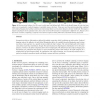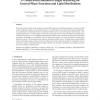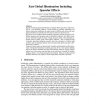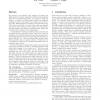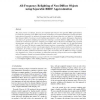117
Voted
TOG
2010
14 years 7 months ago
2010
Accurately rendering glossy materials in design applications, where previewing and interactivity are important, remains a major challenge. While many fast global illumination solu...
103
Voted
CGF
2008
15 years 10 days ago
2008
In translucent objects, light paths are affected by multiple scattering, which is polluting any observation. Confocal imaging reduces the influence of such global illumination eff...
108
Voted
CGF
2010
15 years 26 days ago
2010
Due to the intricate nature of the equation governing light transport in participating media, accurately and efficiently simulating radiative energy transfer remains very challeng...
109
click to vote
RT
2000
Springer
15 years 4 months ago
2000
Springer
Rapidly simulating global illumination, including diffuse and glossy light transport is a very difficult problem. Finite element or radiosity approaches can achieve interactive si...
128
click to vote
SIGGRAPH
1997
ACM
15 years 5 months ago
1997
ACM
We present a new Monte Carlo method for solving the light transport problem, inspired by the Metropolis sampling method in computational physics. To render an image, we generate a...
116
click to vote
ECCV
2010
Springer
15 years 6 months ago
2010
Springer
This paper describes a method to recover scene geometry from the second-bounce of light transport. We show that form factors (up to a scaling ambiguity) can be derived from the sec...
134
Voted
EGH
2003
Springer
15 years 6 months ago
2003
Springer
We capitalize on recent advances in modern programmable graphics hardware, originally designed to support advanced local illumination models for shading, to instead perform two di...
104
click to vote
RT
2004
Springer
15 years 6 months ago
2004
Springer
This paper presents a technique, based on pre-computed light transport and separable BRDF approximation, for interactive rendering of non-diffuse objects under all-frequency envir...
102
Voted
CVPR
2010
IEEE
15 years 6 months ago
2010
IEEE
We propose a new method to analyze light transport in homogeneous scattering media. The incident light undergoes multiple bounces in translucent objects, and produces a complex li...
119
click to vote
CVPR
2009
IEEE
15 years 7 months ago
2009
IEEE
We present a catadioptric projector analogous to a catadioptric camera by combining a commodity digital projector with additional optical units. We show that, by using specially sh...

